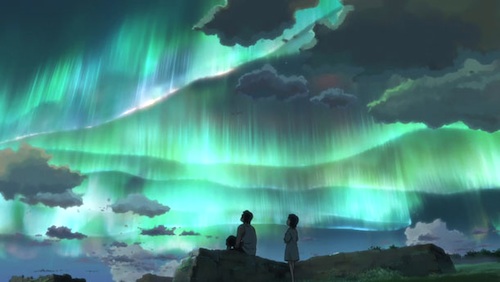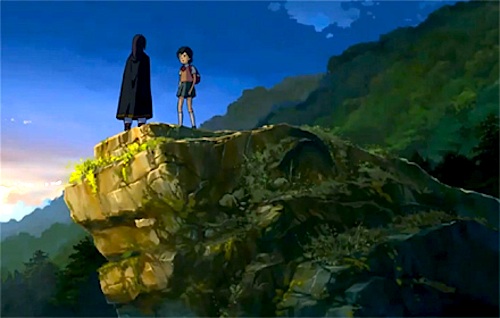
By Joe Bendel. Maybe Edward Bulwer-Lytton and the hollow Earthers were not so wrong after all. There certainly seem to be mystical forces intruding up into the surface world around the Japanese countryside. One shy school girl discovers the fabled subterranean world of Agartha in Makoto Shinkai’s anime epic Children Who Chase Lost Voices from Down Below (trailer here), which screens during the 2012 New York International Children’s Film Festival.
Asuna Watase is a bright student, who works equally hard around the house, as well. After her father’s untimely death, her mother must put in long hours at the hospital to support them. In her mountainside refuge, Watase tunes the crystal radio her father left behind. One day she picks up an otherworldly melody, achingly sad and beautiful in equal measure. Soon thereafter, she is saved from a bizarre Gamera-esque monster by Shun, a mysterious boy roughly her age. He makes quite an impression, but it seems a tragic fate soon lies in store for him.
Though she only briefly knew him, Watase grieves him deeply. As a result, she finds particular resonance in her substitute teacher’s story of Izanago and Izanami, the Japanese variant on the Orpheus and Eurydice myth. Likewise, Mr. Morisaki is very interested in her when he realizes she has made contact with the world beneath. It turns out he has been working with the Arch Angels, a group of “empty-headed Gnostics” outfitted like S.H.I.E.L.D., who have sought the legendary power of Agartha. Unconcerned with such matters, Morisaki seeks to resurrect his late wife. Stranded on the other side with her fanatical sub, Watase accompanies him on his quest, for reasons that are not yet clear to her.

There is a heck of a lot that transpires in Agartha, involving big time mythological archetypes. Highly literate by anime and wider animation standards, Chase is packed with allusions, including periodic nods to the grand old man himself, Hayao Miyazaki. Of course, the diverse mystical fantasyscapes play to Shinkai’s strength. His breathtaking vistas and richly detailed nature studies arguably surpass the recent Studio Ghibli productions.
NYICFF cautions parents that there are several potentially nightmare-inducing scenes in Chase, which is rather good news for grown-up anime fans. True to their billing, Shinkai has created some pretty creepy wraith-like shadow-dwelling creatures, as well as an ancient entity that looks as if it shambled out of a Salvador Dali painting. He also keeps the tension ratcheted up, preying on viewer emotions rather ruthlessly. Indeed, more than just another plucky kid who saves the world, there is something quite touching about the spiritually resilient Watase.
Chase is definitely high-end animation, in both visual and narrative terms. It largely skews towards older kids and general fantasy audiences, but should pay-off handsomely for both groups. Highly recommended, it screens again Saturday (3/10) and the following Sunday (3/18) at the IFC Center, as well as next Saturday (3/24) at the Asia Society, as this year’s NYCIFF continues at venues around the City.
Posted on March 6th, 2012 at 4:29pm.